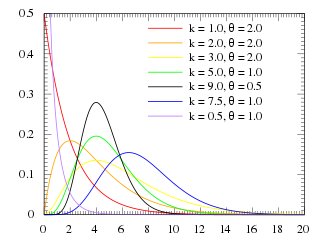|
Probability density function  | |||
|
Cumulative distribution function  | |||
| Parameters | |||
|---|---|---|---|
| Support | |||
| CDF | |||
| Mean | |||
| Median | No simple closed form | No simple closed form | |
| Mode | , | ||
| Variance | |||
| Skewness | |||
| Excess kurtosis | |||
| Entropy | |||
| MGF | |||
| CF | |||
| Fisher information | |||
| Method of moments | |||
In probability theory and statistics, the gamma distribution is a versatile two-parameter family of continuous probability distributions.[1] The exponential distribution, Erlang distribution, and chi-squared distribution are special cases of the gamma distribution.[2] There are two equivalent parameterizations in common use:
- With a shape parameter k and a scale parameter θ
- With a shape parameter and a rate parameter
In each of these forms, both parameters are positive real numbers.
The distribution has important applications in various fields, including econometrics, Bayesian statistics, life testing.[3] In econometrics, the (k, θ) parameterization is common for modeling waiting times, such as the time until death, where it often takes the form of an Erlang distribution for integer k values. Bayesian statistics prefer the (α, β) parameterization, utilizing the gamma distribution as a conjugate prior for several inverse scale parameters, facilitating analytical tractability in posterior distribution computations. The probability density and cumulative distribution functions of the gamma distribution vary based on the chosen parameterization, both offering insights into the behavior of gamma-distributed random variables. The gamma distribution is integral to modeling a range of phenomena due to its flexible shape, which can capture various statistical distributions, including the exponential and chi-squared distributions under specific conditions. Its mathematical properties, such as mean, variance, skewness, and higher moments, provide a toolset for statistical analysis and inference. Practical applications of the distribution span several disciplines, underscoring its importance in theoretical and applied statistics.[4]
The gamma distribution is the maximum entropy probability distribution (both with respect to a uniform base measure and a base measure) for a random variable X for which E[X] = kθ = α/β is fixed and greater than zero, and E[ln X] = ψ(k) + ln θ = ψ(α) − ln β is fixed (ψ is the digamma function).[5]
- ^ "Gamma distribution | Probability, Statistics, Distribution | Britannica". www.britannica.com. Archived from the original on 2024-05-19. Retrieved 2024-10-09.
- ^ Weisstein, Eric W. "Gamma Distribution". mathworld.wolfram.com. Archived from the original on 2024-05-28. Retrieved 2024-10-09.
- ^ "Gamma Distribution | Gamma Function | Properties | PDF". www.probabilitycourse.com. Archived from the original on 2024-06-13. Retrieved 2024-10-09.
- ^ "4.5: Exponential and Gamma Distributions". Statistics LibreTexts. 2019-03-11. Retrieved 2024-10-10.
- ^ Park, Sung Y.; Bera, Anil K. (2009). "Maximum entropy autoregressive conditional heteroskedasticity model" (PDF). Journal of Econometrics. 150 (2): 219–230. CiteSeerX 10.1.1.511.9750. doi:10.1016/j.jeconom.2008.12.014. Archived from the original (PDF) on 2016-03-07. Retrieved 2011-06-02.
























![{\displaystyle k={\frac {E[X]^{2}}{V[X]}}\quad \quad }](https://wikimedia.org/api/rest_v1/media/math/render/svg/79060985aa8683bbf0b380d57ca56522822342ca)
![{\displaystyle \theta ={\frac {V[X]}{E[X]}}\quad \quad }](https://wikimedia.org/api/rest_v1/media/math/render/svg/de7bf8b64325f4129e05929e2385f3ca37bb88bf)
![{\displaystyle \alpha ={\frac {E[X]^{2}}{V[X]}}}](https://wikimedia.org/api/rest_v1/media/math/render/svg/87074b8ec525badd064920b64dcff7be1c51ceaa)
![{\displaystyle \beta ={\frac {E[X]}{V[X]}}}](https://wikimedia.org/api/rest_v1/media/math/render/svg/187bc571898043026331662ae41bb70d4104d429)


